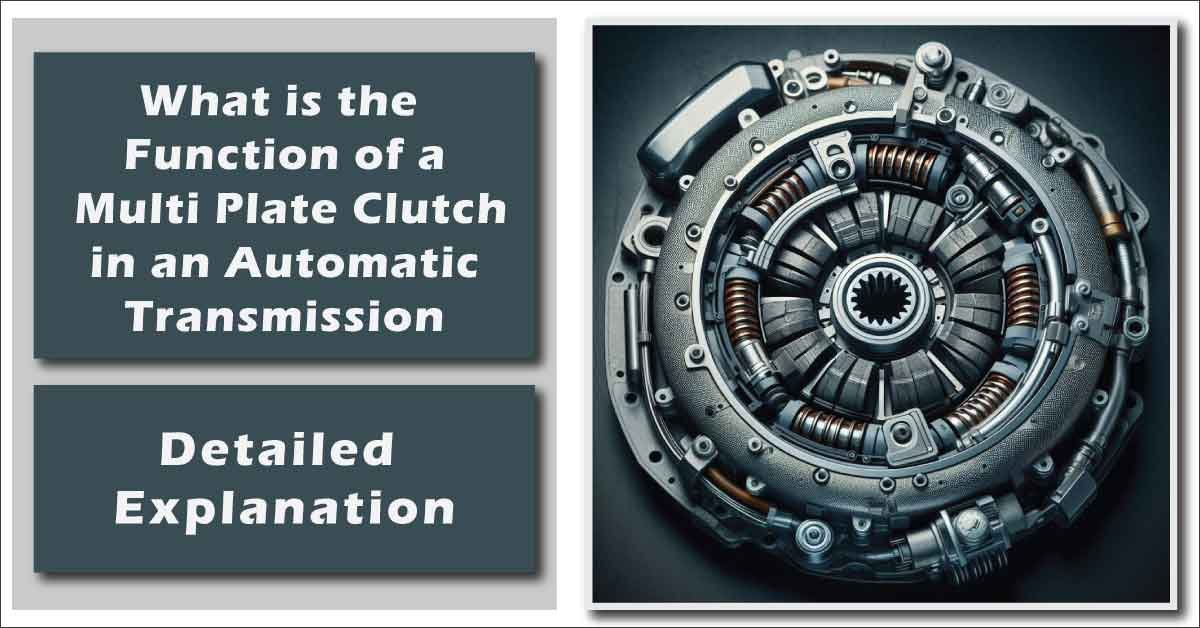A multi plate clutch is capable of transmitting greater torque compared to a single plate clutch due to its design, which incorporates several friction plates. This configuration enhances the overall surface area, resulting in increased frictional force needed for effective power transfer. As a result, multi plate clutches are particularly suited for high-performance vehicles, heavy-duty machinery, and motorcycles, where robust torque management is crucial.
What is the Function of a Multi Plate Clutch in an Automatic Transmission?
A multi plate clutch is a critical component in automatic transmissions, significantly contributing to the vehicle’s overall performance, efficiency, and drivability. This type of clutch employs multiple friction plates, allowing for a smooth transfer of power from the engine to the transmission while enabling seamless gear changes. In this detailed explanation, we will explore the various functions of a multi plate clutch within automatic transmissions, emphasizing its importance in modern automotive engineering.
1. Power Transmission
The primary function of a multi plate clutch in an automatic transmission is to facilitate power transmission from the engine to the transmission. When the engine generates power, the clutch engages to transmit that power to the transmission system, which ultimately drives the wheels.
Engagement and Disengagement:
The clutch is activated by hydraulic pressure, which is controlled by the vehicle’s transmission control unit (TCU). When the driver presses the accelerator pedal, the TCU assesses the vehicle’s speed, load, and engine RPM to determine when to engage the clutch.
Upon engagement, multiple friction plates come together, allowing the engine’s power to flow smoothly into the transmission. When the vehicle slows down or comes to a stop, the clutch disengages, disconnecting the engine from the wheels to prevent stalling.
2. Gear Engagement
Multi plate clutches play a vital role in enabling gear engagement in automatic transmissions. The ability to shift gears seamlessly is crucial for maintaining optimal performance and comfort while driving. Here’s how the multi plate clutch facilitates gear engagement:
Smooth Shifting:
When the TCU decides to change gears, it activates the multi plate clutch, allowing for the engagement of the appropriate gear ratio.
The design of the multi plate clutch provides a larger surface area for friction compared to single-plate clutches, allowing for smoother engagement. As the clutch engages, the transmission can seamlessly shift to the next gear without causing significant disruptions in power delivery, thus enhancing the driving experience.
Adaptive Performance:
Multi-plate clutches can adapt to varying driving conditions, providing different levels of engagement based on factors such as acceleration, deceleration, and load. This adaptability ensures that the vehicle responds efficiently to the driver’s commands, whether they require rapid acceleration or gentle deceleration.
3. Torque Management
In addition to facilitating gear changes, multi plate clutches are designed to manage torque effectively. This is particularly important in automatic transmissions that experience varying torque demands during different driving conditions.
Also Read: Mechanical Maintenance Explained: Basics, Types, Benefits
High Torque Capacity:
Multi plate clutches are capable of handling higher torque levels due to their design, which incorporates several friction plates. This feature is crucial for modern automatic transmissions that are often used in high-performance vehicles.
During acceleration, when torque demand is at its peak, the multi plate clutch engages to transfer power smoothly to the transmission. Conversely, when the vehicle decelerates or comes to a stop, the clutch disengages, allowing the engine to idle without stalling.
4. Heat Dissipation
Automatic transmissions generate considerable heat during operation, especially when the vehicle is under heavy load or during aggressive driving. Multi plate clutches are designed to manage and dissipate this heat effectively.
Lubrication and Cooling:
Many multi plate clutches operate in a lubricated environment, where oil circulates to cool the friction plates and reduce wear. This lubrication helps to prevent overheating, which can lead to premature clutch failure and reduced transmission performance.
The ability to dissipate heat is crucial for maintaining the integrity of the clutch system, ensuring that it operates efficiently over extended periods.
5. Enhancing Fuel Efficiency
Another significant function of a multi plate clutch in an automatic transmission is its contribution to fuel efficiency. By facilitating smooth power transfer and optimizing gear engagement, multi-plate clutches play a vital role in improving a vehicle’s overall fuel economy.
Optimal Engine Performance:
When the clutch engages and disengages at the appropriate times, the engine operates within its optimal RPM range. This efficient operation minimizes fuel consumption and reduces emissions, aligning with modern automotive standards for sustainability.
Additionally, the smooth transitions provided by the multi plate clutch reduce engine load, which further enhances fuel efficiency during various driving conditions.
Also Read: Top 13 Types of Mechanical Tools: Names and Uses
Conclusion
In summary, the multi plate clutch serves several essential functions within an automatic transmission. By facilitating power transmission, enabling smooth gear engagement, managing torque, dissipating heat, and enhancing fuel efficiency, the multi-plate clutch is a vital component that ensures the overall performance and reliability of modern vehicles.
Understanding the role of multi plate clutches highlights their importance in contemporary automotive design, providing drivers with a comfortable, efficient, and responsive driving experience. As automotive technology continues to evolve, the role of multi plate clutches will remain crucial in optimizing transmission systems and enhancing vehicle performance, ensuring that drivers enjoy the benefits of advanced engineering and innovation.

